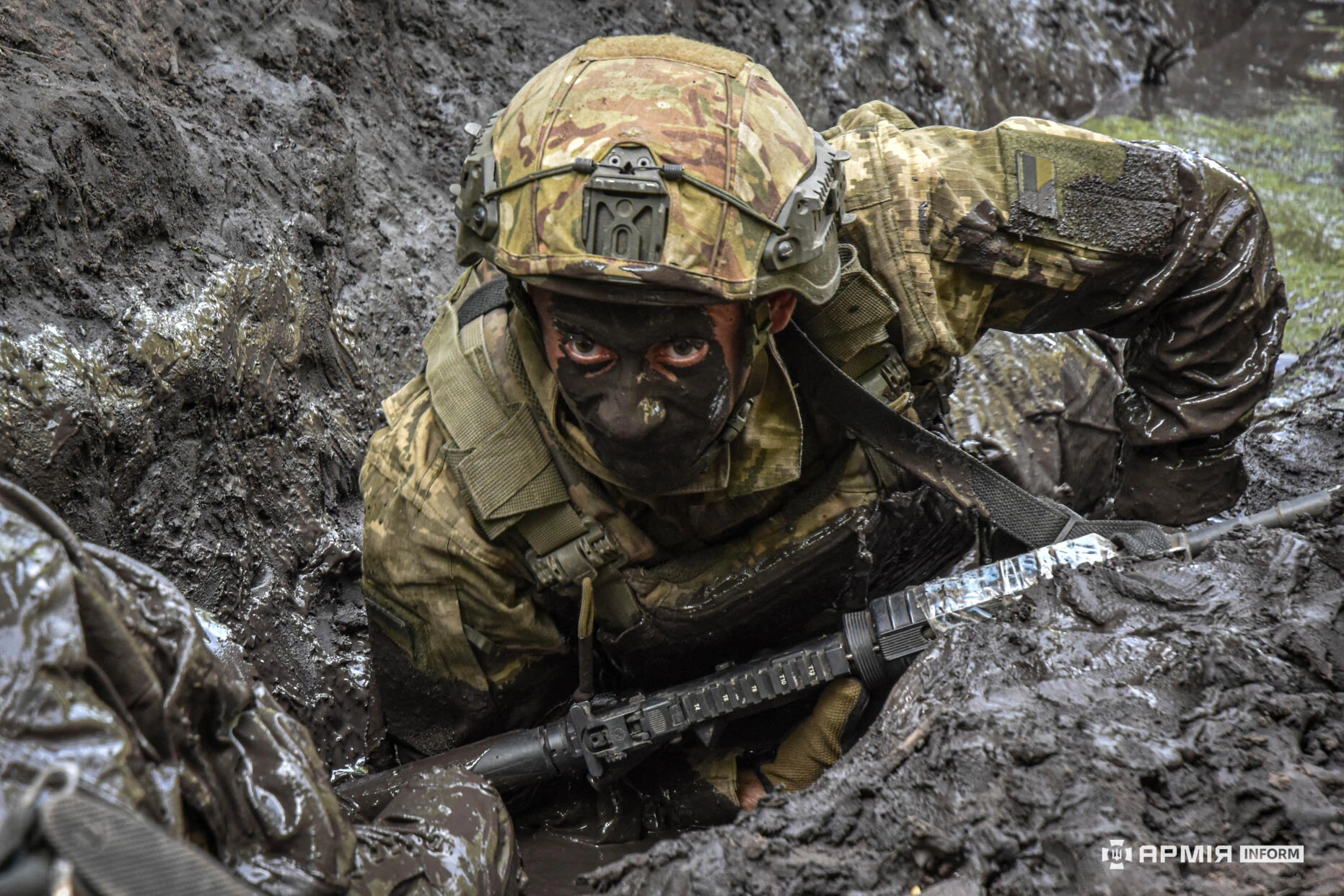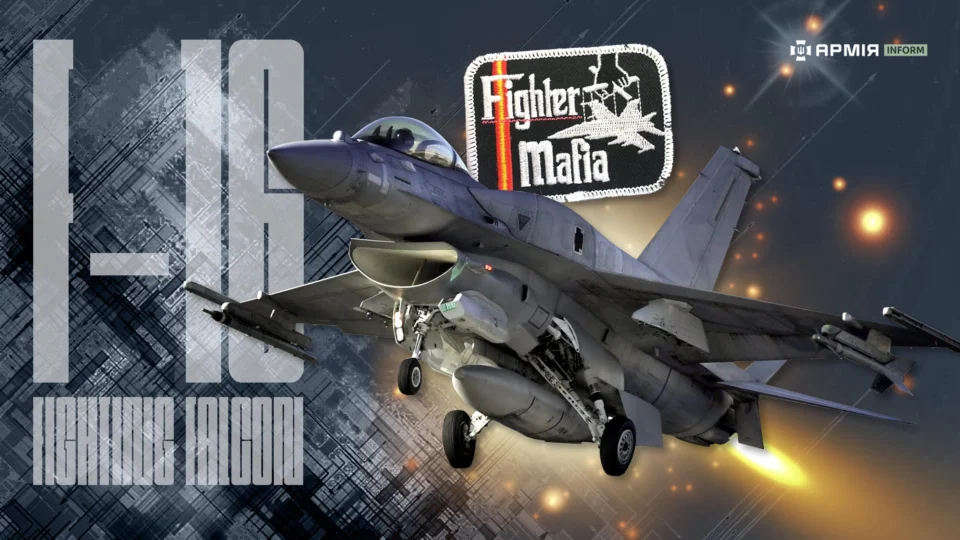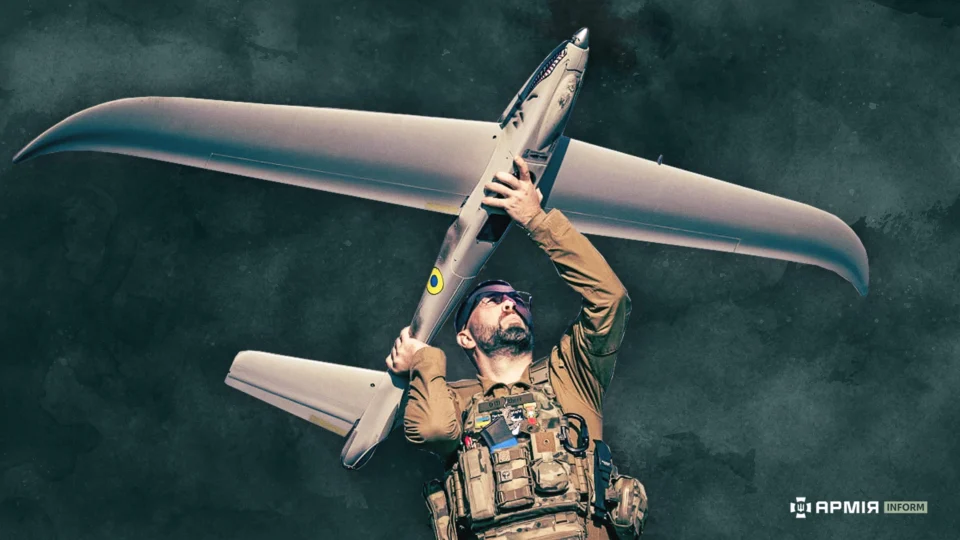A small group of officers and analysts challenged the dominant doctrine of heavy aircraft and proved that the future of…

A journalist from ArmyInform experienced firsthand (with his own eyes and legs) how the fighters of the 503rd Marine Battalion, part of the 38th Marine Brigade, overcame a complex obstacle course to earn the sea-green beret.
Groups of 10–15 fighters line up at the start in the forest. Everyone is in body armor and helmets, carrying weapons. That’s a serious burden, but that’s what real combat is like. Each group is accompanied by 2–3 sergeants and a medic. Sergeants shout commands, which the fighters must repeat and execute.
– March forward!
The fighters, 9 men and 1 woman, set off. For the next five hours, they can only dream about marching at a walking pace.
– Goose step!
The fighters squat, holding weapons above their heads, and move in a crouched walk. Try doing that without a vest, helmet, and rifle.
– Incoming fire!
The fighters drop to the ground to reduce the chance of being hit by shrapnel.
– Down!
Sergeants carry long sticks, pressing down anyone who tries to cheat and doesn’t lie flat.
– On your feet! Double time!
The fighters run, trying to keep formation.
– Enemy at nine o’clock!
The fighters fall and take up defensive positions. Each covers their own sector of fire; someone watches the rear.
– I see smiles, does anyone thinks this is funny? Push-ups! One—two.
The fighters push up. In armor and helmets, it’s no joke.
– I love…
– The Marines!
– Double time!
The squad rises and runs. Ahead is a small forest lake. Reeds, a dead raccoon right on the trail, fighters nearly immediately sink into the muck. Up to their shins, up to their knees, stopping is not an option.
– Enter the water! Move along the shore!
The Marines wade in. Waist-deep, neck-deep; the shorter ones already have to swim.
– Incoming fire!
At this command, they must submerge completely. Any helmets sticking out of the water are whacked with sticks. “Incoming” means “incoming.” Everyone goes under. The group continues moving along the bank, a few more dives, then the order comes to come ashore and take up defense.
– Sectors assigned! Crawl forward!
The fighters crawl uphill through scorched grass. Their wet, muddy uniforms now collect dust.
– Grenade!
A flash-bang explodes loudly. The fighters are already on the ground.
– Goose walk! Lower! Lower!
Someone tries moving with straight legs, but the sergeants make sure every order is executed properly.
– I love…
– The Marines!
The group stretches out. The lead fighters are ordered to wait for those lagging behind. But waiting is no rest.
– Pyramid!
The fighters plant their heads and feet on the ground, fold their arms behind their backs, and hold the position. Or they do push-ups or squats, depending on the order. This teaches them not to break away but to move in sync with the group.
Then again — goose step, crawling, running, squats. The commander suddenly holds up someone’s rifle.
– Who dropped this?
– Me.
– Soldier, that’s a big screw-up. How will you redeem yourself?
They agree on forty push-ups. The soldier does them. The rifle is returned, but one sergeant hands him a nearly two-meter-long log, which he must now carry to the end of the course. He cannot drop it. No one complains or argues.
Marine soldier Kateryna, callsign “Runa,” who earned the sea-green beret:
“I never thought about quitting. I worried more for my comrades who had it harder than me. The most difficult part for me was crawling — and we had to crawl for a long time. But it was an incredible experience. It’s not just about receiving the beret; it’s like a symbolic baptism, when you truly become part of the Marine Corps. That means a lot to me. For those who are only preparing to earn the beret, I’ll say this: get ready, prepare well. And don’t start just a week before.”

The group emerges from the forest into a field. Two long logs await. They must be lifted and carried at a run. The fighters line up by height, otherwise the shorter ones can’t reach the log with their shoulders. They carry it. Along with the log, weapons, and extra burdens: the log, and a wheel nicknamed the “pill,” standing in for a medic’s pack.
– Push-ups! One!
The group drops and lowers to the ground on their hands. The command “Two!” — to straighten arms — does not come. Sticks thump body armor to force those who simply fell flat to actually perform the exercise.
– Two! One!
Everyone is gasping, exhausted, and realizes they’ve barely covered a third of the course.
– How do you feel?
The commander asks the only woman in the group.
– Great!
– Then we’re not working hard enough. Let’s add weight!
More push-ups, crawling, squats. Vests and helmets grow heavier by the minute. For the next few hundred meters, the group either crawls or goes goose step. They reach a sandy road and crawl along it. I notice with surprise that some uniforms have already dried. They crawl to an armored “Kozak” vehicle. Now they must push it. The group splits: some at the rear, some at the sides. They start pushing the 15-ton machine. On sand, it’s no easy task, especially since the driver lightly brakes. On an incline, the vehicle stops, and the group can’t move it. First try, second, third. The fighters are exhausted.
– I love!
– The Marines!
– Why so weak! Shall we do push-ups? I love!
– The Marines!
They shout loudly — no one wants push-ups. Finally, they’re allowed to leave the “Kozak”. Then again — crawling and goose step. One fighter collapses, revived with smelling salts. The group rushes into the forest again. A tent of black plastic awaits, black smoke seeping from its cracks.
– Gas masks on!
The fighters put them on, place their left hand on the shoulder of the comrade ahead, and file into the tent. Inside, in darkness and smoke, they wait for several minutes.
– No one leaves without an order! yells the tent’s overseer — a huge Marine, 130 kilograms, with a long pine stick. – I love…
– The Marines!
– Why so weak? I love!
– The Marines!
– Putin!
– …uylo!
– You’ve no idea how hard it is to shout in a gas mask!
The Marine waits, then gives the order to exit. The fighters dash out, getting smacked on the helmets with that pine stick.
– This one’s new! When a major went through, I broke my stick on him! shouts the Marine. Everyone knows on the obstacle course, all are equal; rank doesn’t matter.
They surrender gas masks and immediately run on — climbing log fences and more tasks. Another fighter vomits. Everyone holds pyramid position, since resting on the course is forbidden. Then they move again.
– We’ve got a casualty! You and you! Shout!
Those singled out fall, screaming. Their comrades drag the “wounded,” straining to carry them. Exhausted arms fail, but abandoning the injured is not allowed, so they keep dragging.
– What, too hard? Want to quit and ride back to the truck?
No one volunteers to quit. Meanwhile, the commander snatches the rifle from the woman fighter. She does forty squats and gets an extra log to carry. The group moves on, and soon the smell of rotting meat fills the forest. Barbed wire is strung half a meter off the ground, with animal entrails hung from it — very rotten, judging by the stench. They must crawl underneath. Sergeants and the commander poke the entrails to intensify the stench. The fighters crawl. Some vomit, but don’t stop. One fighter throws up after every meter, but crawls through all the same.
Deputy Commander of the 38th Marine Brigade, Colonel Maksym:
“The beret test is taken only by those who have served in the Marines at least six months. Everyone must undergo a medical exam, since the strain will be very serious. All brigade units take part: headquarters, medics, artillerymen, engineers. Officers and enlisted, men and women — all run the same course. Today, for example, a deputy battalion commander, a major, took the test. He went through it on equal terms with everyone else. Those who serve in the Marines understand and respect this tradition. Earning the beret is prestigious. Not only in service, but afterwards, in civilian life. The beret is something to be proud of.”

Next are exercises with car wheels. They must be slung over the neck and carried while running and squatting. Plus the rifle, plus other loads. One fighter falls, seemingly on the verge of unconsciousness. The commander reaches for his weapon.
– Let me help, I’ll take it.
The commander tries to grab the rifle, but the nearly unconscious Marine clutches it in a death grip, refusing to let go. The commander smiles.
– Oh, you’ll make a fine Marine. Out cold, but you won’t give up your weapon!
The soldier is revived with ammonia. Next — truck wheels. They must be flipped. The group is utterly exhausted, but the sergeants won’t let them stop. Another fighter suffers heatstroke. The group forms a pyramid, water poured over his head. Then more running, more crawling. They re-enter the forest. A torn-up road lies ahead, full of deep ruts filled with water.
– Into the rut!
The group drops one by one into the mud and crawls. Some fighters lost magazines; they now redeem them from the commander by diving headfirst into the muck.
– I love!
– The Marines!

The cool mud seems to revive the group, which surges forward to assault abandoned houses. A bend in the forest road — and ahead the battalion flag comes into view. The order: crawl. The fighters crawl, and suddenly two fire hoses blast them. The water pressure flips some over, but the others crawl on, dragging penalty logs and wheels. In the final meters, sergeants grab at their legs to hold them back — but they can’t be stopped. One fighter reaches the flag and seizes it. The course is complete. Others crawl in too, still under water spray. They collapse to the ground, silent for several minutes. Wild-eyed, as if they still don’t believe they made it through.
Afterward, their names are recorded, and they’re led to a mobile field bathhouse. Half an hour later, the Marines return washed, in clean uniforms, unrecognizable. A solemn formation follows: they recite the Marine oath, and then the commander places the well-earned beret on each of them. By tradition, the beret must be “driven in” — a powerful palm strike on the Marine Corps badge. The badge is metal, and the blow can split the skin on the forehead. Some end up bleeding. But after all they endured, no one pays it any mind.
@armyinformcomua

President of Ukraine Volodymyr Zelenskyy reported that National Security and Defense Council Secretary Rustem Umerov and Chief of the General Staff Andriy Hnatov will hold a series of meetings in Brussels with national security advisers of European leaders.

Throughout the autumn, the intensity of hostilities increased. In November, the number of recorded combat engagements exceeded this year’s average monthly figures.

The F-16 Fighting Falcon project was born in defiance of the system. This revolutionary multirole fighter entered service thanks to the Fighter Mafia, which lobbied for the project and overcame resistance from conservative generals.

The wars of the 21st century impose unprecedented demands on the protection of military equipment.

He paid a 700-hryvnia fine just to gain the opportunity to become a volunteer in the Armed Forces of Ukraine.

Volodymyr Zelensky spoke about the preparation of peace agreements and the difficulties along this path.
A small group of officers and analysts challenged the dominant doctrine of heavy aircraft and proved that the future of…